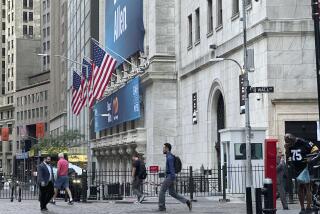Computer Firm’s Flux Could Push Japan Past U.S.
- Share via
SAN FRANCISCO — There were only about 250 supercomputers in operation around the world at the end of last year, and no more than 40 are expected to be sold this year.
But despite the low numbers, no product better symbolizes the fierce race for technological supremacy between the United States and Japan than the supercomputer.
“It is an emotional subject, bound up in questions of national pride and national security,” said Gregory P. Kosinski, senior industry analyst for Dataquest, a San Jose market research firm.
At an average price of $14 million apiece, these are the fastest and most powerful computers ever created. They are used for such sophisticated scientific applications as breaking foreign codes, designing aircraft and forecasting weather.
Fifteen-year-old Cray Research of Minneapolis controls about 75% of the market, which is expected to grow at an annual rate of 27.9% through 1991. But some observers believe that Cray’s decision on Wednesday to scrap its most advanced computer development project, coupled with the project designer’s decision to leave the company, has thrown into question Cray’s--and the nation’s--long-term dominance of the business.
“I don’t see any big winners in the short term,” said William D. Easterbrook, an analyst with Kidder, Peabody & Co. in San Francisco. “But by the time we get to 1991 or 1992, the big winners could be the Japanese.”
In interviews Thursday, Cray’s competitors were quick to celebrate the leader’s stumble. “It’s a big event,” said Samuel W. Adams, vice president for marketing of Honeywell-NEC Supercomputers, a joint venture between U.S. and Japanese computer firms.
“This is the first time Cray has stubbed its toe in 15 years, and they have done so very publicly,” Adams added.
Steve Hemping, vice president for administration of ETA Systems, Control Data’s supercomputer unit, said “we feel very well-positioned to take advantage of the market for the next generation of supercomputer. This certainly can’t hurt us.”
Certainly, Cray took a drubbing on Wall Street. After plunging $8.50 a share on Wednesday, the company’s stock lost an additional $6.75 on Thursday, closing at $97.75 on the New York Stock Exchange.
Master Designer Exits
“The announcement casts suspicion on where the company is going,” said analyst John Rutledge at Dillon Read & Co. in New York.
Of special concern to investors, analysts noted, was news that master computer designer Steven S. Chen had decided to leave Cray.
Chen headed one of two competing development groups within the company; the other is headed by company founder Seymour Cray. Chen’s group, many of whose members are expected to follow him to whatever company he joins or new venture he forms, created the world’s most successful supercomputers, the Cray X-MP/2 and X-MP/4.
But other analysts believe the stock market has overreacted. “You could argue that this helps Cray by helping them to better focus their development efforts,” Dataquest’s Kosinski said.
With outside competition--particularly from NEC and Control Data’s ETA--heating up, competing design teams were a luxury Cray could no longer afford, Kosinski suggested.
Cray still has two major development projects, though they are not as ambitious as Chen’s, which envisions machines up to 100 times as powerful as any existing ones.
Each of Chen’s planned supercomputers would have had up to 100 processors, or “brains,” which would divide problems up in order to compute solutions much more quickly through what is known as parallel processing. Most supercomputers perform calculations by sheer force, running operations through a single speedy processor.
Just last month, the usually secretive U.S. National Security Agency said it has started work on its own multimillion-dollar parallel processing supercomputer project.
Paul B. Schneck, director of the agency’s Supercomputing Research Center, said the agency embarked on the project--which is expected eventually to employ up to 100 scientists--because private industry had become too risk-averse.
LEADING SUPER COMPUTER FIRMS
Company Supercomputers installed through 1986 Cray Research 148 Control Data/ETA 41 Fujitsu* 38 Hitachi 11 NEC** 6
* Including computers marketed by Amdahl and Siemens ** Including computers marketed by Honeywell Source: Dataquest Inc.




